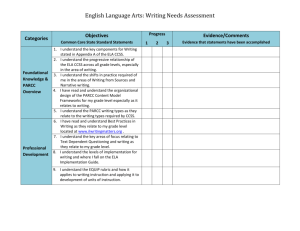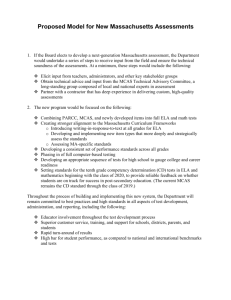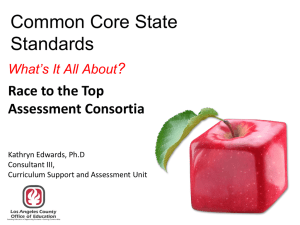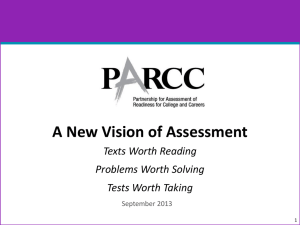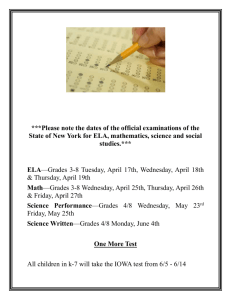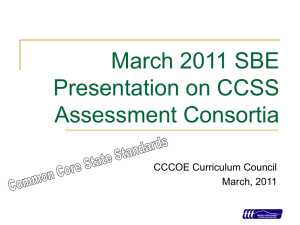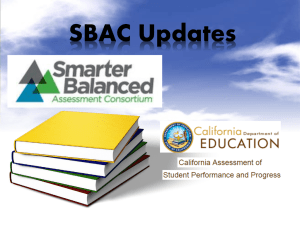Lucille E. Davey's PowerPoint
advertisement
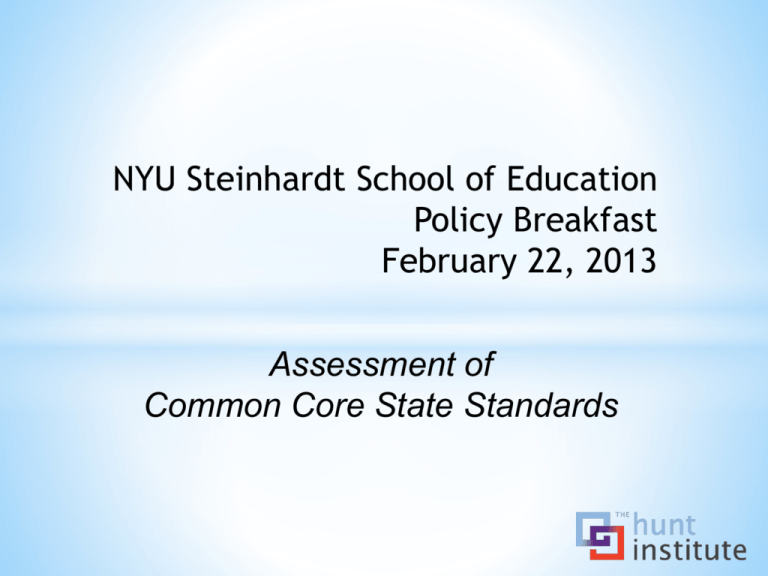
NYU Steinhardt School of Education Policy Breakfast February 22, 2013 Assessment of Common Core State Standards Next Generation Assessments: The U.S. Department of Education has funded two consortia of states with development grants for new assessments aligned to the Common Core State Standards • Rigorous assessment of progress toward “college and career readiness” • Common cut scores across all Consortium states • Provide both achievement and growth information • Valid, reliable, and fair for all students, except those with significant cognitive disabilities • Administer online • Use multiple measures • Operational in 2014-15 school year Source: Federal Register / Vol. 75, No. 68 / Friday, April 9, 2010 pp. 18171-85 Partnership for Assessment of Readiness for College and Careers (PARCC) • 19 governing states and 3 participating states that collectively educate about 24 million students • Build a pathway to college and career readiness by end of high school • ELA and math tests in grades 3 to 8 and high school assessing CCSS • Assessment blueprint aligned to Model Content Frameworks • Computer delivery; use technology to increase student access and engagement • Develop and adopt a common set of performance standards; scoring rubrics will be comparable across all states • Build capacity in states through leadership teams, teacher cadres • Field testing begins – spring 2013; full scale field testing in spring 2014 • Full operational administration – spring 2015; achievement levels including college ready performance will be set after first administration Goals of the PARCC System 1. Create high-quality assessments 2. Build a pathway to college and career readiness for all students 3. Support educators in the classroom 4. Develop 21st century, technology-based assessments 5. Advance accountability at all levels 6. Build an assessment that is sustainable and affordable PARCC: Claims Driving ELA Design Students are on-track or ready for college and careers Students read and comprehend a range of sufficiently complex texts independently Reading Literature Reading Informationa l Text Vocabulary Interpretatio n and Use Students write effectively when using and/or analyzing sources. Written Expressio n Conventions and Knowledge of Language Students build and present knowledge through research and the integration, comparison, and synthesis of ideas. PARCC: Claims Driving Math Design Students are on-track or ready for college and careers Students solve problems involving the major content* for their grade level with connections to practices Students solve problems involving the additional and supporting content* for their grade level with connections to practices Students solve real world problems engaging particularly in the modeling practice *See PARCC Model Content Frameworks for details Students express mathematical reasoning by constructing mathematical arguments and critiques Student demonstrate fluency in areas set forth in the Standards for Content in grades 3-6 5 Components of the PARCC Assessment System #1 Diagnostic assessment – (optional) computer based items to pinpoint strengths and weaknesses for that grade’s standards; bank of PBAs with samples scored; online PD for teachers; flexible timing of administration #2 Mid-year assessment – (optional) primarily rich PBA tasks designed to inform curriculum, instruction and PD; preview those in #3; flexible administration #3 Performance based assessment –focus on hard-to-measure standards; short, medium and extended tasks including computer-enhanced simulations; administered as close to end of year as possible; mix of human and computer scoring; results expected within 2 weeks of completion; results combined with EOY to determine summative score #4 End of year comprehensive assessment – in combination with PBA, assess all grade level standards; online during last few weeks of school year; range of innovative item types entirely computer scored; scale score within one week of administration #5 Speaking/Listening assessment – required but not used for summative; scored by teachers using standardized rubric ELA Item Prototypes Grade 6: Narrative writing Part A Question: What does the word “regal” mean as it is used in the passage? a. generous b. threatening c. kingly* Grade 10: Prose constructed response Use what you have learned from reading "“ Daedalus and Icarus"”by Ovid and “ "To a Friend Whose Work Has Come to Triumph"”by Anne Sexton to write an essay that provides an analysis of how Sexton transforms “ Daedalus and Icarus.” d. Uninterested Part B Question: Which of the phrases from the passage best helps the reader understand the meaning of “regal?” As a starting point, you may want to consider what is emphasized, absent, or different in the two texts, but feel free to develop your own focus for analysis. a. “wagging their tails as they awoke” b. “the wolves, who were shy” c. “their sounds and movements expressed goodwill” d. “with his head high and his chest out”* http://parcconline.org/samples/item-task-prototypes Develop your essay by providing textual evidence from both texts. Be sure to follow the conventions of standard English. Word document is used for the response. Math Sample Items Grade 3: Mathematics Fluency Click on all of the equations that are true: o 8 x 9 = 81 o 54 ÷ 9 = 24 ÷ 6 o 7 x 5 = 25 o8x3=4x6 o 49 ÷ 7 = 56 ÷ 8 High School (Seeing Structure in an Equation) It is given that: 24 10x x 2 p (x 5) 2 Find the value of P . When you are finished, enter your answer below. P = http://parcconline.org/samples/item-task-prototypes Smarter Balanced Assessment Consortium (SBAC) • 21 governing states and 3 advisory states that collectively educate about 40% of the nation’s students • Build a pathway to college and career readiness by end of high school • ELA and math tests in grades 3 to 8 and grade 11 assessing CCSS • Standardized and customized reporting on an interactive platform for accountability including growth • Build capacity in states through multi-state collaborative with CCSSO; train educators to write and review items; state teacher cadres • Design curriculum materials aligned to learning progressions using content experts collaborating with professional organizations, universities and non-profits for the Digital Library • Pilot testing in sample of schools – spring 2013; full scale field testing in March 2014 • Preliminary standards setting – August 2014; Fully operational summative assessment – 2015 Goals of the SBAC System 1. Strategically balance summative, interim and formative assessments through an integrated system of standards, curriculum, assessment, instruction and teacher development 2. Align to the Common Core State Standards and researchbased learning progressions 3. Students leave high school prepared for postsecondary success in college and career through increased student learning and improved teaching 4. Leverage technology using adaptive testing, technology enhanced items, teacher online access to resources and instructional tools SBAC: Content Claims for ELA/Literacy Students are on-track or ready for college and careers Students can read closely and analytically to comprehend a range of increasingly complex literary and informational texts Students can produce effective and wellgrounded writing for a range of purposes and audiences Students can engage in research and inquiry to investigate topics, and to analyze, integrate and present information Students can employ effective speaking and listening skills for a range of purposes and audiences Claims for grades 3-8 are delineated into four content achievement level descriptors and claims for HS are delineated into four policy achievement level descriptors. SBAC: Content Claims for Math Students are on-track or ready for college and careers Students can explain and apply mathematical concepts and carry out mathematical procedures with precision and fluency Students can solve a range of complex, wellposed problems in pure and applied mathematics, making productive use of knowledge and problemsolving strategies Students can analyze complex, real-world scenarios and can construct and use mathematical models to interpret and solve problems Students can clearly and precisely construct viable arguments to support their own reasoning and to critique the reasoning of others Claims for grades 3-8 are delineated into four content achievement level descriptors and claims for HS are delineated into four policy achievement level descriptors. Components of the SBAC Assessment System • Summative assessments – taken during final 12 weeks of the SY; two major components: performance tasks and comprehensive end-of-year computer adaptive test • Performance tasks – delivered on computer; evaluate difficult to assess standards; organized around real-world scenarios and complex tasks; could include production of an extended response; results within two weeks after test is completed • Computer adaptive assessment – 40-65 questions in each content area; selected-response, constructed response, and technology-enhanced items; most will be immediately scored; includes a retake option as determined locally • Optional interim assessments – computer adaptive mirroring those on the summative including performance tasks; open item bank; provide teachers with instructionally useful information; resources • Formative exemplars – 3 modules for each grade in each content area; address learning progressions and include formative tasks, scoring rubrics and student work samples ELA Sample Items Grades 3-5: Read the sentences from the passage. Then answer the question. “My grandma pulled the ball out, unwrapped it, and held it out for us to see. The ball was scarred almost beyond recognition. It had dog bite marks, dirt scuffs, and fraying seams. Right in the middle was a big signature in black ink that I had somehow overlooked. It was smudged now and faded, but it still clearly said ‘Babe Ruth.’ I began to shake inside.” Click on two phrases from the paragraph that help you understand the meaning of scarred. High school: Read this sentence from the passage. “Besides being beautiful to contemplate, space diamonds teach us important lessons about natural processes going on in the universe, and suggest new ways that diamonds can be created here on Earth.” Explain how information learned from space diamonds can help scientists make diamonds on Earth. Use evidence from the passage to support your answer. Type your answer in the space provided. http://sampleitems.smarterbalanced.org/itempreview/sbac/ELA.htm Math Sample Items Grades 3-5: Problem-solving fractions Five friends ordered 3 large sandwiches. James ate 3/4 of a sandwich. Kate ate 1/4 of a sandwich. Ramon ate 3/4 of a sandwich. Sienna ate 2/4 of a sandwich. How much sandwich is left for Oscar? Answer is a grid-in. Grades 6-8: Expressions and Equations 1 Look at each expression. Is it equivalent to 36x + 24y? Select Yes or No for expressions A – C. A. 6(6x + 4y) yes B. 30(6x – 6y) yes C. 12(x + 2y + 2x) yes http://sampleitems.smarterbalanced.org/itempreview/sbac/index.htm# no no no Common Work of PARCC and SBAC • Collaboration with higher education • Teacher engagement • Library of resources for educators • Evidence-centered design • Universal design • Attention to accessibility, sensitivity and bias • Technology needs and assessment • Comparability of results They are not in competition with one another; they are working together to create a 21st century assessment system that provides greater educational value and better measures the knowledge and skills needed for success in college and careers.
